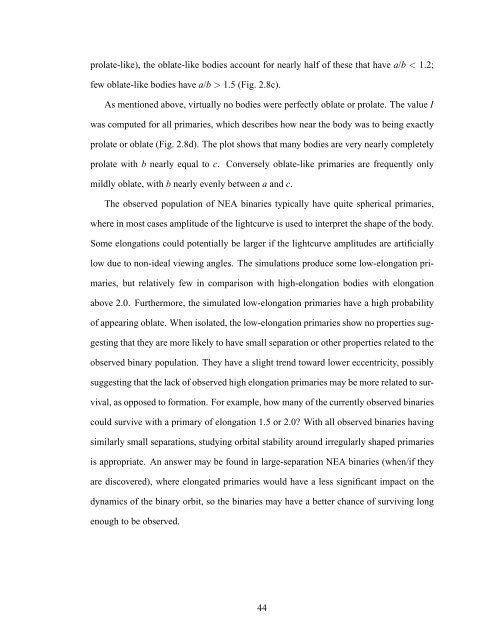Forming Binary Near-Earth Asteroids From Tidal Disruptions
Forming Binary Near-Earth Asteroids From Tidal Disruptions
Forming Binary Near-Earth Asteroids From Tidal Disruptions
You also want an ePaper? Increase the reach of your titles
YUMPU automatically turns print PDFs into web optimized ePapers that Google loves.
prolate-like), the oblate-like bodies account for nearly half of these that have a/b < 1.2;few oblate-like bodies have a/b > 1.5 (Fig. 2.8c).As mentioned above, virtually no bodies were perfectly oblate or prolate. The value Iwas computed for all primaries, which describes how near the body was to being exactlyprolate or oblate (Fig. 2.8d). The plot shows that many bodies are very nearly completelyprolate with b nearly equal to c. Conversely oblate-like primaries are frequently onlymildly oblate, with b nearly evenly between a and c.The observed population of NEA binaries typically have quite spherical primaries,where in most cases amplitude of the lightcurve is used to interpret the shape of the body.Some elongations could potentially be larger if the lightcurve amplitudes are artificiallylow due to non-ideal viewing angles. The simulations produce some low-elongation primaries,but relatively few in comparison with high-elongation bodies with elongationabove 2.0. Furthermore, the simulated low-elongation primaries have a high probabilityof appearing oblate. When isolated, the low-elongation primaries show no properties suggestingthat they are more likely to have small separation or other properties related to theobserved binary population. They have a slight trend toward lower eccentricity, possiblysuggesting that the lack of observed high elongation primaries may be more related to survival,as opposed to formation. For example, how many of the currently observed binariescould survive with a primary of elongation 1.5 or 2.0? With all observed binaries havingsimilarly small separations, studying orbital stability around irregularly shaped primariesis appropriate. An answer may be found in large-separation NEA binaries (when/if theyare discovered), where elongated primaries would have a less significant impact on thedynamics of the binary orbit, so the binaries may have a better chance of surviving longenough to be observed.44












